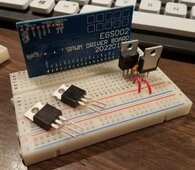Hi, I have big and heavy low frequency 27V > 120/240V toroidal transformer from parted out Xantrex 6048 inverter. I would like to make MOSFET H-bridge inverter and PWM controller to drive it. So far I found IPP016N08NF2S 80V 196A 1.6mOhm MOSFETs on mouser that look pretty good for low frequency commutation side at least. I may have to model their switching losses at PWM freq or look for other FETs with acceptable switching loss for high side of the H-bridge.
Has anyone here done this kind of project? Any pointers for controller software, gate driver and current protection? I would like this to be a pure sine wave inverter.
Thanks.
Has anyone here done this kind of project? Any pointers for controller software, gate driver and current protection? I would like this to be a pure sine wave inverter.
Thanks.





